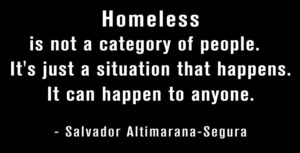Healing 1: Serving the Hungry with an Understanding Heart
“You, God, are my God, earnestly I seek you; I thirst for you, my whole being longs for you, in a dry and parched land where there is no water.” – Psalm 63:1
“That person lives in Shandaken. He shouldn’t even be here.”
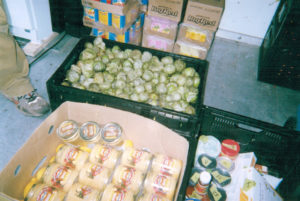
The pantry served shoppers, volunteers, hungry people. Volunteers fed everyone in the line. No exceptions.
Distributing groceries brought forgiveness and healing. Healing was an after thought of forgiveness.
For me, healing required some commitment and thought. Whether or not this was true, questions always arose:
“Am I ready to be healthy?”
“Can I get well if it’s scary?”
“Can I leave the old me aside if it’s necessary for healing?”
“Why am I going through this?”
“What is the meaning of it all?”
These questions could be painful. Healing can be hard on everyone.
The pantry line had massage therapists, Reiki practitioners, medical intuitives, and other healers.
As a healer, I know healing happens on several levels in our lives: physical, mental, spiritual, emotional, mythical. Both healing and getting well were special challenges because many of the people in the hallway, the pantry room, and out in the parking lot didn’t have health care.
While he had his office, Woodstock had Dr. Longmore. After his office closed, things were tough for many. As health care became scarce, everyone became personally involved with the differences between healing and getting well. For some, this was part of the spiritual journey.
Hunger often went beyond a plate of beans or a jar of peanut butter. That’s why food is essential to healing. That’s where homemade soup comes in.
Sharing food in the pantry helped people heal. Fresh vegetables, eggs, and Bread Alone bread offered a healing experience with abundance. As we fed the shoppers, we helped ourselves and each other.
In some cases, the shoppers became the volunteers or the volunteers joined the shoppers. Shoppers came to get food and found they could volunteer. Volunteering changed them. As a person distributed groceries, the volunteer made contact with another person and was able to smile.
Pantry experiences coaxed us out of our own problems. Offering a sense of community gives back so much more.
Do you want to be healed? Healing and feeding are connected.
Sooner or later, we all get sick. Finally, we die.
No one escapes. This truth is harder on hungry people who have no $$$ for health care.
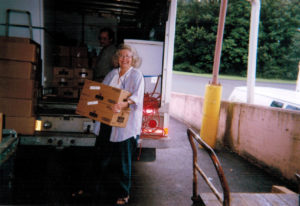
Hungry people are often blamed for their inability to deal with the situation. It’s as if it’s their fault for being down and out in Woodstock. If they lived right, they would be healthier, make more $$$ in their jobs.
If critics stopped and thought about how insufficient nutritious food, improper housing, and inadequate or nonexistent healthcare impacts a person, they might feel differently.
What did it matter that there were no jobs in the area and none of those that came open paid over $8.00 an hour?
Because they were down and out, they must be guilty of something.
They were negative thinkers, lacking faith, and basically lazy. Something.
They were gay, trans, promiscuous, alcoholics. Something.
They were freeloaders, irresponsible, flaky. Something.
Healing and getting well are two different things, acting in different ways. But, whether a person heals, gets well, or both, change happens.
“Do I want to heal?”
“Do I want to be well?”
“What if I come out of this experienced a different person?”
“What if it takes a long time?”
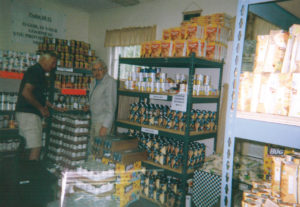
In the midst of this, the pantry offered some normalcy to the shattered lives of hungry people when they took pantry food home to wherever and whatever that was, fixed a meal, and served it to those in the household.
It was supper from the pantry.
Health issues pointed to the spiritual challenges which popped up on the path to the pantry. Healing was on the agenda. We all wanted to get well.
People getting well overcome symptoms. Getting well means doctor’s visits, therapy, pills, creams. These things were simply not an option for pantry shoppers because there was no money.
Symbolic healing occurred in the hallway on pantry days as shoppers and volunteers discussed their diabetes, PTSD, cancer, allergies.
Working and shopping in the pantry was therapy to volunteers and shoppers. These hallway conversations were cheaper than the physical and mental health services they had no money for anyway.
These conversations were essential because talking about a health issue promotes healing. Shared symptoms gave us all support, strength, validity.
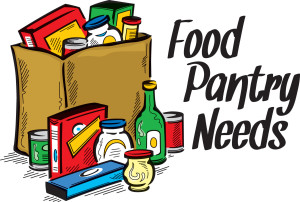
Everyone walking through the door to the pantry, whether a shopper or volunteer, was asked to leave the past behind. This experience was different for everyone. But, think about it, how can we move forward into our new lives if we never give anything up.
For some, giving up the past means letting go of things lost: the job, the home, maybe the family, self-esteem, the car, good health, money, insurance, the pet, anger, or drugs.
As the past disappears, the remaining spiritual baggage weighs less and less. Prejudices become fewer. Fears diminish. We heal!
Some things surrendered were physical, some mental, and some emotional. But, one thing is certain, whatever the category, the experiences all had a spiritual aspect.
Giving and receiving food brought everyone a little peace.
Everyone coming to the pantry heals somehow. The pantry community supports and approves hungry individuals as they climb back on the road to wellness and something offering normalcy.
Nobody just wakes up one day and says “I think I’ll go down to the local food pantry and volunteer.” People spending time in pantries all travel down the path. Healing has signposts along the way.
Some needed physical healing. Volunteers occasionally came to the pantry so ill that they were barely able to make it into the building. When this happened, I stationed them at the Items of Dignity table distributing toilet paper, shampoo, razors. They offered one roll of toilet paper and one other item to each shopper.
 Each week, Deanna slowly walked the two blocks to the pantry and then worked in the hallway a couple of hours while she gathered enough energy to return home.
Each week, Deanna slowly walked the two blocks to the pantry and then worked in the hallway a couple of hours while she gathered enough energy to return home.
“Don’t forget your roll of toilet paper, Judith. We’ve got some hand cream today. Can you use that or would you prefer tooth paste?”
When Deanna finally couldn’t work in the hallway anymore, Rachel gracefully sat at the Items of Dignity table helping shoppers choose their two items. Rachel lived in nearby Mt. Tremper. Her living situation seemed somewhat precarious because every few months she looked for a new place to live. She lived in her car a couple of times.
Thank you for reading this blog post. This is the first food pantry article on healing.
Please forward this article with your preferred social media network. Share it with a friend.
If you are interested in healing, please check out my other blog: www.reflexologyforthespirit.com.
Thanks again.
Thurman Greco
Woodstock, NY
PS: Many programs are now uploaded to YouTube. More are being added weekly. Enjoy!
![]()
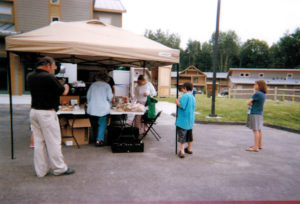

Grocery shopping is always a problem for the elderly.
I first met her outside the shed at the Reservoir Food Pantry. A recent widow, I heard her comment “I just never knew how hard it was going to be as a widow.” Her husband died just over a year ago and she’s still making her way toward accepting her new reality.
“I never knew it would be so difficult…being alone like this. I’ll never tell my children I come here. I don’t want them to know.”
As she spoke, she wiped an occasional tear while moving through the pantry line with a group of women, all about her own age. They were choosing corn and apples, squashes, greens, onions, potatoes. As the line snaked forward, she turned her attention to the canned goods: beans, soup, fruits, veggies.
Pat hasn’t made it to the food stamp office in Kingston. For one thing, it’s a good half hour down Route 28. For another, she’s afraid:
of the forms,
the humiliation of being unable to survive on her own,
the long wait in a building she may not even be able to find,
finally, she’s afraid of the whole process which she finds frightening.
Her financial situation isn’t so far from all the other older women in the pantry line. Grocery shopping for the elderly is difficult under the best of circumstances. Getting to the grocery store can be challenging for older people – getting around in the parking lot and going up and down the grocery store aisles is no fun anymore. And, then, when they can’t find what they need, they have to maneuver the muddy parking area and the scary entrance ramp at the pantry. And…we haven’t even discussed the packages yet. They’ve got to be gotten home and in the house (wherever and whatever that is).
Finally, getting high quality, affordable food is more and more difficult as the days go by. And, as difficult as it is for Pat, she’s one of the lucky ones. She’s got a working automobile.
Combine the lack of a working automobile, bad weather, not enough $$$ and you’ve got the makings of a disaster for a senior.
I keep telling everyone who’ll listen that seniors should get their SNAP card, a list of nearby pantries, and their first social security check at the same time. So far, nobody has listened. Of course not. Why should they? We’ve all got gray hair.
Seniors struggle with the big 3:
food
housing
medical expenses.
Forget the extras like clothing. As seniors, we get less, pay more, and go without. When I need something new to wear, I go to the boutique of my closet.
Healthcare costs can be devastating, even to a senior with medicare. Once a person comes down with cancer or other expensive disease, the pocketbook empties pretty fast.
There is real pressure to feed the rising tide of hungry people at every pantry. We get questionnaires periodically from different agencies wanting to know how often we run out of food. How does “weekly” sound?
The Big 3 for pantries include:
high unemployment
widespread poverty
deep cuts in social spending programs.
Pantries, for the most part, are
arbitrary,
subjective,
strongly biased
when it comes to deciding who can and cannot receive food. There are simply too many agencies with too many people standing in line for too little food for any food bank or state office to properly oversee and supervise the selection process.
As far as feeding the hungry, we’re not even coming close to filling the need created by the widespread poverty and deep spending cuts. People in food pantry lines are, in a severe winter, choosing between eating and heating.
Our pantry, housed in a shed, an old green house, and the back of a restaurant is a ragtag emergency food movement which is in reality not emergency at all.
Lines and crowds outside our pantry on Monday afternoons can easily convince any onlooker that the good old U S of A has a food problem.
http://www.reservoirfoodpantry.org
Thank you for reading this blog/book.
Please send a comment.
Please share this article with your preferred social media network.
Don’t forget to join the email list.
Peace and food for all.
Thurman
The Big 3: We get less, pay more, and do without.
WHAT GROCERIES CAN YOU BUY FOR $16?
(The Minium SNAP Allotment)
Prices from Kingston Walmart
– 1 dozen eggs – $1.98
– 1/2 gallon milk – $1.94
– 1 lb. pinto beans – $1.28
– 1 lb. rice – $ .84
– 1 lb. onions – $ .99
– 1 can diced tomatoes – $ .79
– 1 lb ground turkey – $2.98
– 1 can corn – $ .77
– 1 lb. potatoes – $2.97
– 1 can tuna – $ .78
Total = $15.32
I first met Pat last fall when she came to the Reservoir Food Pantry the first time. She’s an older woman, a widow. Her husband died just over a year ago She’s still making her way toward her new life.
“I never dreamed it would be so hard…being alone like this. I didn’t tell my children that I came here. I don’t want them to know the situation.”
While she spoke, she wiped an occasional tear. She moved through the pantry line composed of a group of women, all about her own age. They chose corn, apples, squash, late season greens, onions, potatoes. As the line snaked forward, she turned her attention to the canned goods: beans, soup, fruits, veggies.
Pat hasn’t visited the SNAP (food stamp) office in Kingston yet. For one thing, it’s a good half hour down Route 28. For another, she’s afraid:
the forms,
the humiliation of being unable to survive on her own,
the long wait in a building that she may not even be able to find. And, finally, she’s afraid of the whole process which she finds threatening.
Her financial situation isn’t so far from all the other women in the pantry line. Grocery shopping for the elderly is difficult under the best circumstances. Getting to the grocery store can be challenging for order people – getting around in the parking lot and going up and down the grocery store aisles is no fun anymore. Then, when they can’t find what they need at a price they can afford, they have to maneuver the muddy parking lot and the scary entrance ramp at our pantry.
We haven’t even discussed the packages yet. They’ve got to be gotten home and in the house wherever and whatever that is.
Finally, finding affordable high quality food becomes more difficult as the days go by. As difficult as it is for Pat, she’s one of the lucky ones. Her automobile works.
The combination of a nonworking automobile, bad weather, insufficient $$$ is the makings of a disaster for a senior.
I keep telling everyone who will listen that seniors should get their SNAP card, a list of nearby pantries, and their Medicare card at the same time. So far, nobody has heard.
“Of course not.” I tell myself. “Why should they? We’ve all got gray hair.”
Seniors struggle with the Big 3:
food
housing
medical expenses.
Forget the frills like Kleenex and clothes. As seniors, we get less, pay more, and go without. We decide whether to heat or eat.
Healthcare costs can be devastating, even to a senior on medicare. Once a person comes down with cancer or other major disease, the pocketbook empties pretty fast.
There is a real pressure to feed the rising tide of hungry at every pantry. We receive questionnaires periodically from different agencies wanting to know how often we run out of food. How does “weekly” sound?
The Big 3 for pantries include:
high unemployment,
widespread hunger
deep cuts in social spending programs.
Every pantry is different. Some feed anyone who needs food.
Others are arbitrary and biased when it comes to deciding who can or cannot receive food.
Yet others require paper work which cuts eliminates the homeless entirely.
There are too many agencies with too many people standing in line for too little food. No Food Bank office can oversee or supervise the selection process.
At Reservoir Food Pantry, we serve a 3-day-supply of food with a large dash of dignity to all who come.
The lines and crowds outside pantries can easily convince any onlookers that our nation has a food problem.
Thank you for reading this blog/book.
Please share this article with your preferred social media network.
I hope you found this article helpful. Please leave your comments below and check out our other posts.
Don’t forget to join the email list.
Peace and food for all.
Thurman Greco



